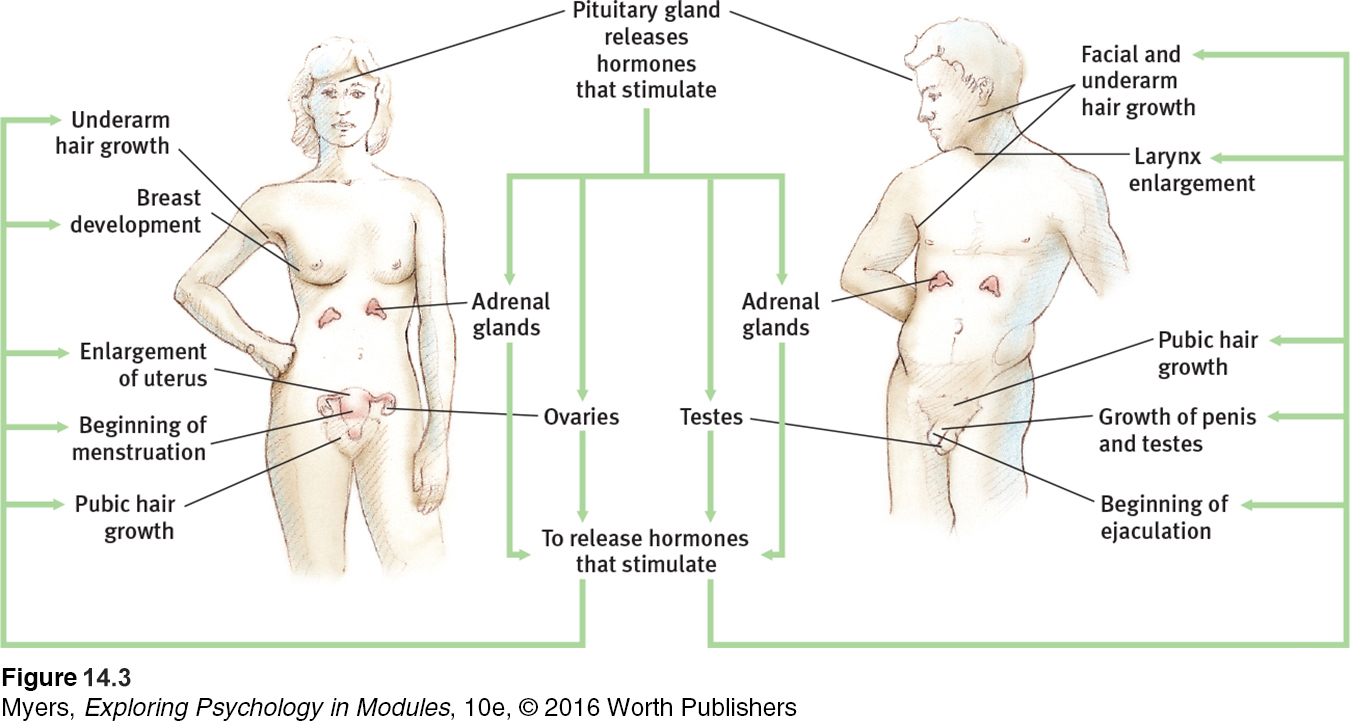14.2 The Nature of Gender: Our Biological Sex
14-
In many physical ways—
Biology does not dictate gender. But in two ways, biology influences gender:
Genetically—
males and females have differing sex chromosomes. Physiologically—
males and females have differing concentrations of sex hormones, which trigger other anatomical differences.
These two influences began to form you long before you were born.
Prenatal Sexual Development
X chromosome the sex chromosome found in both men and women. Females have two X chromosomes; males have one. An X chromosome from each parent produces a female child.
Y chromosome the sex chromosome found only in males. When paired with an X chromosome from the mother, it produces a male child.
Six weeks after you were conceived, you and someone of the other sex looked much the same. Then, as your genes kicked in, your biological sex—
testosterone the most important of the male sex hormones. Both males and females have it, but the additional testosterone in males stimulates the growth of the male sex organs during the fetal period, and the development of the male sex characteristics during puberty.
About seven weeks after conception, a single gene on the Y chromosome throws a master switch, which triggers the testes to develop and to produce testosterone, the principal male hormone that promotes development of male sex organs. (Females also have testosterone, but less of it.)
Later, during the fourth and fifth prenatal months, sex hormones bathe the fetal brain and influence its wiring. Different patterns for males and females develop under the influence of the male’s greater testosterone and the female’s ovarian hormones (Hines, 2004; Udry, 2000).
Adolescent Sexual Development
puberty the period of sexual maturation, when a person becomes capable of reproducing.
A flood of hormones triggers another period of dramatic physical change during adolescence, when boys and girls enter puberty. In this two-
primary sex characteristics the body structures (ovaries, testes, and external genitalia) that make sexual reproduction possible.
secondary sex characteristics nonreproductive sexual traits, such as female breasts and hips, male voice quality, and body hair.
Girls’ slightly earlier entry into puberty can at first propel them to greater height than boys of the same age (FIGURE 14.2 below). But boys catch up when they begin puberty, and by age 14, they are usually taller than girls. During these growth spurts, the primary sex characteristics—the reproductive organs and external genitalia—


spermarche [sper-
For boys, puberty’s landmark is the first ejaculation, which often occurs first during sleep (as a “wet dream”). This event, called spermarche, usually happens by about age 14.
Pubertal boys may not at first like their sparse beard. (But then it grows on them.)

menarche [meh-
 For a 7-
For a 7-
In girls, the landmark is the first menstrual period, menarche, usually within a year of age 12½ (Anderson et al., 2003). Genes play a major role in predicting when girls experience menarche (Perry et al., 2014). But environment matters, too. Early menarche is more likely following stresses related to father absence, sexual abuse, insecure attachments, or a history of a mother’s smoking during pregnancy (DelPriore & Hill, 2013; Rickard et al., 2014; Shrestha et al., 2011). In various countries, girls are developing breasts earlier (sometimes before age 10) and reaching puberty earlier than in the past. Suspected triggers include increased body fat, diets filled with hormone-
Girls prepared for menarche usually experience it positively (Chang et al., 2009). Most women recall their first menstrual period with mixed emotions—
RETRIEVE IT
Question
Prenatal sexual development begins about weeks after conception. Adolescence is marked by the onset of .
Sexual Development Variations
disorder of sexual development a condition present at birth that involves unusual development of sex chromosomes and anatomy.

Sometimes nature blurs the biological line between males and females. When a fetus is exposed to unusual levels of sex hormones, or is especially sensitive to those hormones, the individual may develop a disorder of sexual development, with chromosomes or anatomy not typically male or female. For example, a genetic male may be born with normal male hormones and testes but no penis or a very small one.
In the past, medical professionals often recommended sex-
Sex-
The bottom line: “Sex matters,” concluded the National Academy of Sciences (2001). Sex-